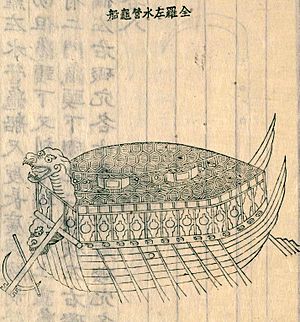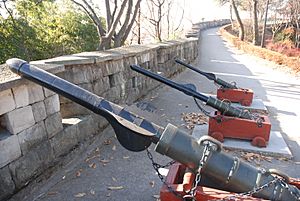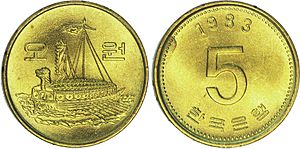Turtle ship facts for kids
A turtle ship (Korean: 거북선; RR: geobukseon) was a special warship used in Korea a long time ago. These ships were used from the early 1400s all the way up to the 1800s. They got their name because their top looked like a turtle's shell!
Contents
When Were Turtle Ships Used?
The very first turtle ships, called gwiseon, were used around 1413. However, they were not used for very long back then.
Turtle ships became famous during a big war against Japanese forces. This war happened from 1592 to 1598, when Japan tried to take over Korea. A brave Korean leader named Admiral Yi Sun-sin is known for making better turtle ships. He won many battles against the Japanese navy.
His improved turtle ships first appeared in the Battle of Sacheon. They helped win 16 battles against the Japanese fleet. Sadly, the Korean navy had a big loss in the Battle of Chilcheollyang when a different commander was in charge.
How Were Turtle Ships Designed?
Later turtle ships were built with taller sides. This allowed them to have more openings for weapons or for air to get inside. The top of the ship was covered with flat, six-sided plates. These plates were made of wood or iron. Both older and newer turtle ships were designed to be very fast. They could move using both oars and sails.
What Was the Roof Like?
Some old writings say that the turtle ship's roof was covered with metal plates. If this is true, it would make them the first armored ships in history! It is clear that the roof had sharp iron spikes. These spikes were there to stop enemies from jumping onto the ship. However, historians are still not sure if the entire ship was covered in iron.
Why Did They Have Spikes?
The metal spikes on top of the turtle ship were used to stop Japanese soldiers from boarding. Sometimes, these spikes were covered with empty rice bags or mats. This was a trick to make the Japanese think it was safe to board. But when they tried, they would get hurt by the spikes!
What Weapons Did Turtle Ships Have?
Turtle ships had many different types of cannons called chongtong. These included the cheonja (heaven), jija (earth), hyeonja (black), and hwangja (yellow) types. There was also a smaller gun called a seungja (victory). The seungja could shoot about 200 meters. The hwangja was the lightest cannon but could shoot the farthest, up to 1,200 meters.
One Japanese record from a battle in 1592 described fighting turtle ships. It said that the turtle ships kept attacking by firing large fire-arrows very close to their ships. As a result, almost every part of the Japanese ships was destroyed.
A dragon's head was placed at the front of the ship. Different kinds of dragon heads were used. The dragon's head was first used to scare Japanese soldiers. One type of dragon head could even release thick, smoky gas. This smoke made it hard for the Japanese to see and move their ships.
Where Can You See Turtle Ships Today?
You can see models of turtle ships in several museums. There is even a full-size turtle ship that you can visit and go inside in Yeosu, Korea.
The Geobukseon Research Center has built new, real-size turtle ships. These have even been used in a Korean TV show called The Immortal Admiral Yi Sun-sin.
Images for kids
See also
 In Spanish: Barco tortuga para niños
In Spanish: Barco tortuga para niños





